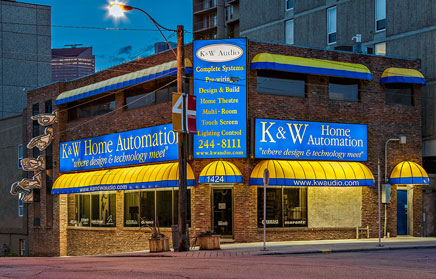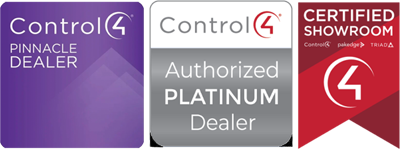Tip # 38:
Let’s dream that you’ve won the lottery. You pay off the mortgagee, then sell the house and buy the home of your dreams. You give a ton to charity, and throw a party for all your friends and family. When they leave, they each receive a big check. Your kids will never be wanting, and your future is more than secure. Now it’s toy time. The car, a truck and motorcycle you’ve always wanted. Oh, yeah… the stereo. Not just any stereo, but a full on home theatre, with line quadrupled projection TV, plasma TV’s everywhere, high end distributed audio throughout with security, and computer access. Wow!
Or not? You carefully weigh all the options, balanced against the household budget and that kitchen renovation you could do with the same money, and make that once in ten to twenty year purchase of an Audio/Video system. In either of these scenarios you are faced with two common denominators. Number one, your happiness isn’t guaranteed. Number two; you’ve got remotes.
No matter how cool the system, what is the most important single component? The user interface, in most cases better known as the remote control (the POWER!!). The ability to operate and fully utilize today’s Audio/Video systems on a day to day basis is defined by the remote control. You insert software into the playback component of choice, sit back and reach for a remote.
The world’s first remote controlled stereo receiver became available in 1977. Bang and Olufsen released the 2400 receiver, and the 6-function remote it came with started a revolution. Today there are remotes for everything, and that can be a bit of a problem. If you buy an average system, you could easily have seven remotes to master. These remotes will do pretty much everything you need, but you will need a new coffee table just to put them all in one place! This has not been lost on the manufacturers that be.
The first solution to arrive on the scene was the Pre-Programmed remote. It comes with the codes to operate a variety of components. Depending on level of sophistication it may only control products made by the manufacturer that produced it, limiting its usefulness in most applications. The most advanced versions have many manufacturer’s codes available, assignable to specific locations. Better, but often only basic control is available even if the code is present for your particular items, which isn’t always the case.
The answer to these drawbacks is, to different degrees, addressed in the current state-of- the-art remote control – the Learning Remote. An ever-increasing range of suppliers makes a dizzying array of these critters, and one of them will do what you need. Which one is right for you? Sorry, no short answer here, but we can outline the different options for you. You (or your friendly specialist) will have to look at your needs, and find a remote that fills them. Let’s take a look.
Most of today’s quality Audio/Video receivers come with a learning remote. This means that some of the buttons are provided to specifically operate components other than the receiver that it came with. Quite often this is enough. While this ìincludedî remote will learn the basic functions of the commonly utilized components (DVD, VCR, CD, TV Tuner and itself), they rarely have the memory or correctly labeled number of buttons to perform all the remote functions that each component is capable of. This means you leave off menu functions, timer programming, and other items you would access only occasionally. For many this is fine. To program this type of remote, we simply butt the remote of the unit you want to learn up against the learning remote, push the button you want to program on the learning unit and then the button on the remote you want to have.
The next step is the after-market Learning remote control. Even at their most basic level, it will do more than the one that came with the A/V receiver. They range in price from a few hundred to over ten thousand dollars! All their buttons are programmable. Programming these guys can be as simple as a pre-programmed or “included” remote, or as complex as requiring a dedicated remote programmer, who uses a computer and specific software (don’t try this at home kids, they are professionals!). The components you want to control, ergonomics, looks, and level of control are reflected in the price.
There are two types of learning remotes, push button and touch screen. At any price level you will have your choice. Some like the high tech look of a touch screen, and the ability to show multiple pages, like a bank machine without seeing all of your options at once. Some like the tactile feel of pushing a button, thus knowing that something is supposed to happen now, and one can feel what one is doing without looking at the remote, or in the dark. Both are great, and reliable so decide what you prefer.
The two features that really enhance any learning remote are the ability to issue “macro” commands, and the ability to monitor system status. Macros issue a bunch of remote codes with a push on one single key. Push once and the Receiver, DVD, and TV turn on. You can add other remote controlled devices such as lights, window shades, popcorn maker… the options are endless. Arthur C. Clarke said, “…any sufficiently advanced technology is indistinguishable from magic…”. With macros, you make your own magic.
Arbitrarily turning all the power on and off is great, but what if one of the components was on already? It will be switched off on the way by. When this occurs, you must manually turn them all off, turn up the lights, open the shades and start over again. Monitoring each component’s status is the arena for the most exotic learning remotes. These require a specialist, and are the high end in performance and price. They offer maximum control, no mater how complex the tasks you want performed with one touch.
No matter what your needs, a remote is out there that will take care of them. To make sure that your new, single do it all remote truly does it all, you must know the components and the ancillary equipment you wish to control. Come see your friendly specialist and assess the remotes based on your needs. Then sit back, and perform magic!


